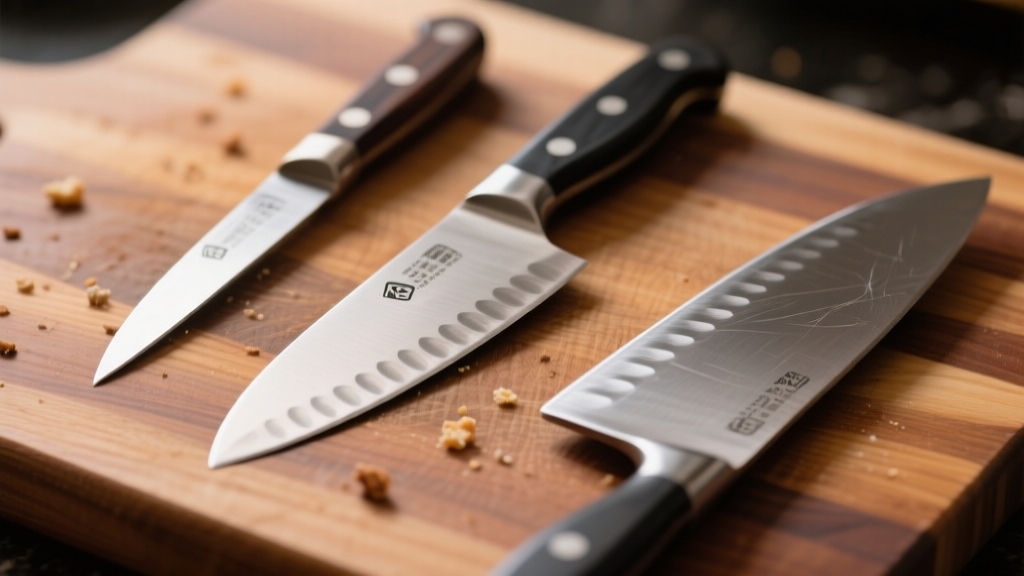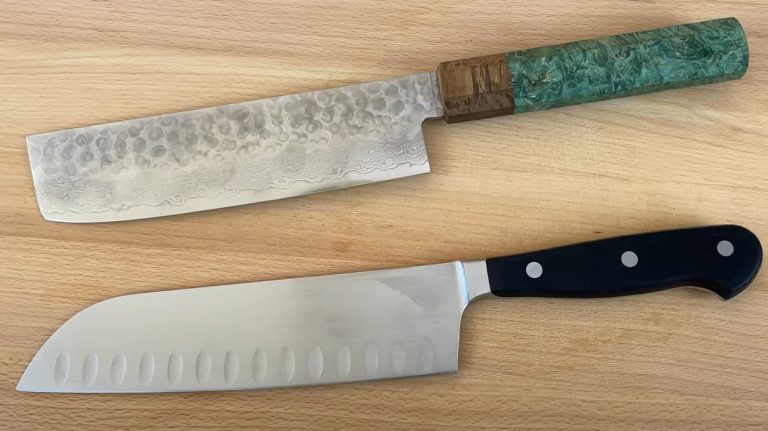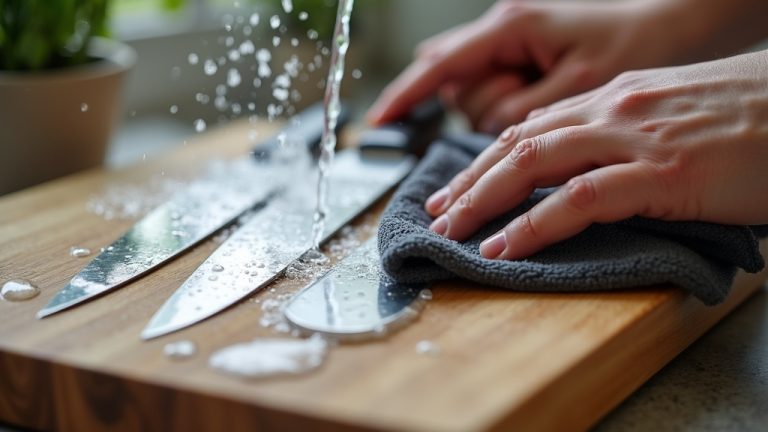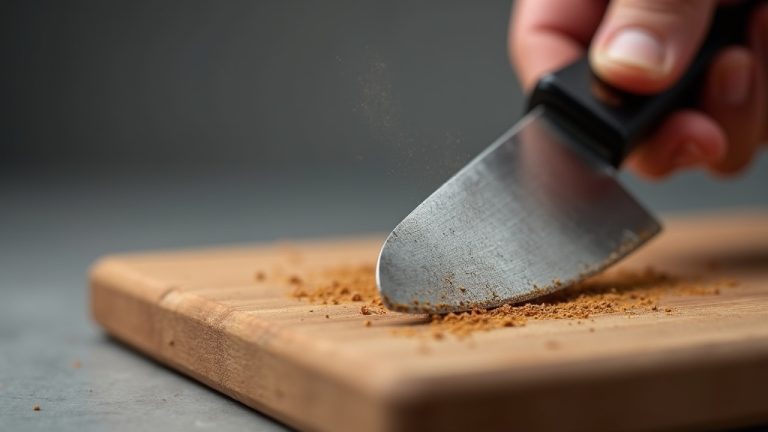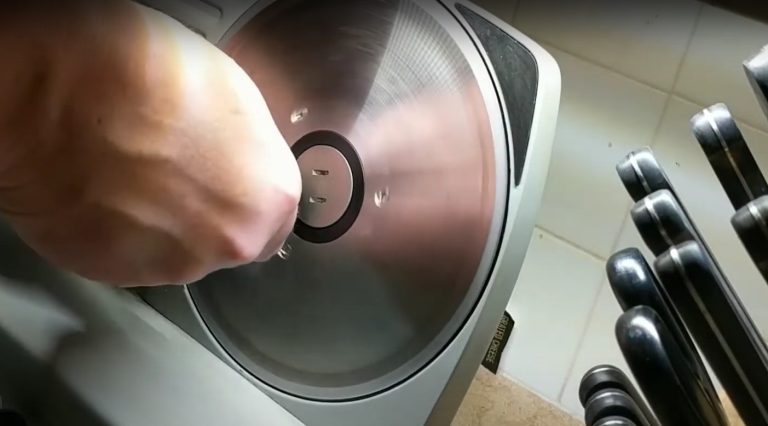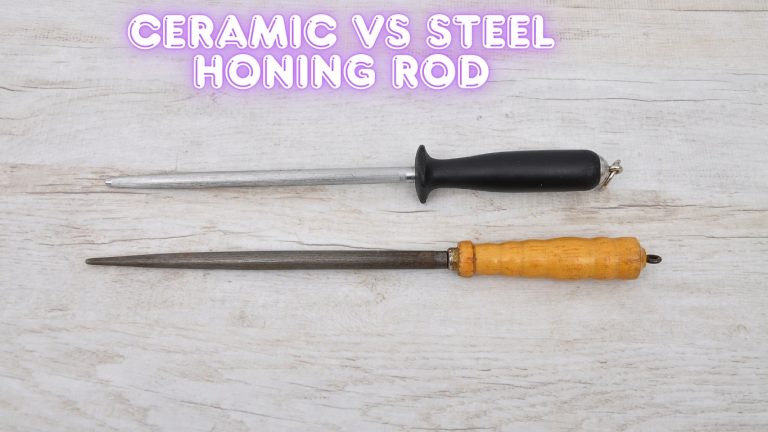What Angle Should Kitchen Knives Be Sharpened?
You should sharpen your kitchen knives between 15° and 20° per side, with sharper angles around 10°–15° for precision slicing. Wider angles closer to 20° offer durability.
The ideal angle depends on your blade’s steel hardness, grind type, and intended use. Maintaining the manufacturer’s recommended angle ensures maximum edge performance and longevity.
Using angle guides or marker tests helps you keep consistency. Understanding these factors will refine how you sharpen and maintain your knives effectively.
Key Takeaways
- Western kitchen knives typically sharpen at 15°–20° per side, with 20° common for durability and heavy use.
- Asian knives favor narrower angles of 10°–15° per side for sharper, more precise cutting edges.
- Always follow manufacturer-specified angles to maintain optimal blade performance and longevity.
- Harder steel supports narrower angles (~15°), while softer steel requires wider angles (~20°) for edge durability.
- Use angle guides, the Tormek Marker Method, or protractors to consistently maintain the proper sharpening angle.
Common Sharpening Angle Ranges for Kitchen Knives
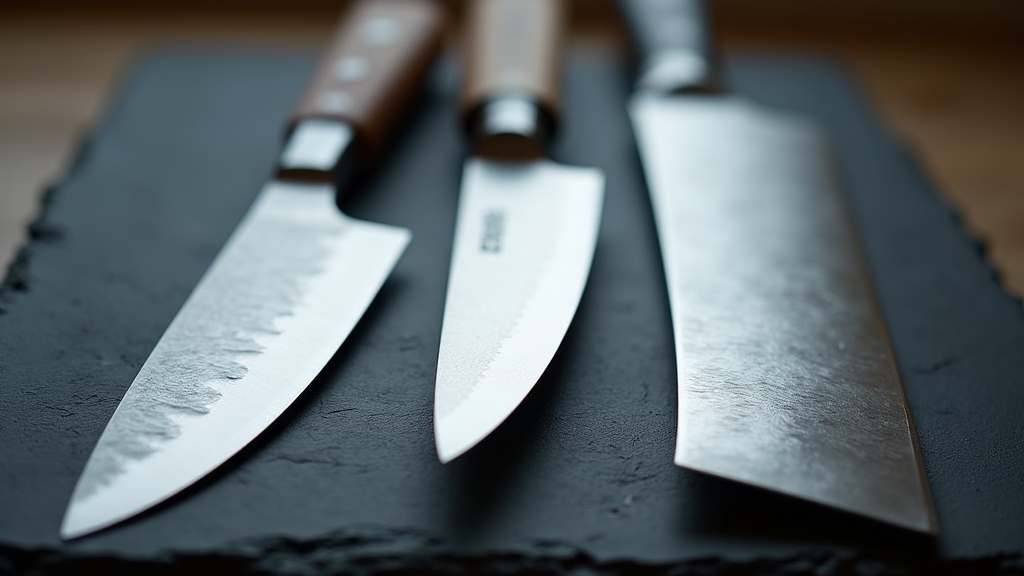
While sharpening angles vary across knife styles, you’ll typically find Western kitchen knives sharpened between 15° and 20°, whereas Asian knives favor narrower angles from 10° to 15°. Applying a proper protective finish to your cutting boards can complement the sharpness of your knives and extend the life of both tools by preventing wood damage through moisture and wear (protective finishes).
Western kitchen knives sharpen between 15° and 20°, while Asian knives prefer sharper angles of 10° to 15°.
Western knives, including brands like Wusthof and Zwilling, commonly use a 20° angle, providing a robust edge suitable for heavy chopping and cutting dense foods. This thicker edge enhances durability and prevents chipping.
In contrast, Asian knives such as santoku and nakiri sharpen at approximately 15°, producing a thinner, sharper edge ideal for precision slicing but less resistant to heavy-duty tasks. Choosing the proper angle is crucial for knife performance.
The harder steel in many Japanese knives supports maintaining these narrow angles without rapid wear.
Understanding these ranges helps you balance sharpness and durability, ensuring ideal knife performance for your culinary needs.
Manufacturer and Blade-Dependent Angle Recommendations
When it comes to sharpening your knives, it’s really important to stick to the angle recommended by the manufacturer. This helps keep your blade performing at its best and ensures it stays durable.
You see, the geometry of the blade plays a big role in these recommendations. Different brands and types of knives might’ve varying angles, all designed to optimize how well they cut. Maintaining a consistent sharpening angle is crucial for preserving the blade’s integrity and sharpness over time.
But what if you don’t have the angle? No worries! You can use tools like the Tormek Marker Method. This handy technique helps you replicate the factory edge accurately, so you don’t have to stress about getting it just right.
Manufacturer Angle Guidelines
Since sharpening angles substantially affect a knife’s performance and durability, manufacturers provide precise guidelines tailored to blade style and steel hardness. Choosing the correct angle is essential because lower angles yield sharper edges but can reduce durability.
Western-style knives typically sharpen at 20° per side, balancing sharpness and edge retention. Asian blades like Santoku often require narrower angles, around 10°–15°. Using an optimal sharpening angle enhances the knife’s cutting efficiency and overall lifespan.
Harder steels (≥60 HRC) may use micro-bevels at about 20° to enhance edge life. Always consult packaging or official sites for model-specific angles.
Maintaining these angles guarantees maximum cutting efficiency and longevity.
| Knife Type | Typical Angle (° per side) | Notable Brands | Steel Hardness Effect | Angle Range (°) |
|---|---|---|---|---|
| Western Chef | 20–22 | Wüsthof, Zwilling, Dalstrong | Micro-bevels on ≥60 HRC | 15–25 |
| Asian Kitchen | 10–15 | Shun, MAC, Global | Hard steel favors narrower | 10–16 |
Blade Geometry Influence
Although the ideal sharpening angle primarily depends on steel hardness and knife type, blade geometry considerably influences angle selection and edge performance.
Single bevel knives, common in traditional Japanese styles, feature flat or concave bevels that require precise acute angles (10°–15°) to maintain sharpness without compromising edge strength.
Double bevel knives usually balance angles between 15° and 20° per side, optimizing durability and cutting efficiency for all-purpose use.
The bevel shape, whether hollow ground, convex, or flat, alters the effective cutting angle, affecting edge resilience and maintenance frequency.
Thinner bevels produce finer edges but need more frequent sharpening, while wider bevels enhance toughness for heavy chopping.
Manufacturers tailor sharpening angles by evaluating blade geometry alongside steel properties to harmonize sharpness, durability, and intended culinary tasks.
It is important to understand the bevel as the critical section where stones interact to form the edge, influencing the sharpening process.
You should respect these design factors to preserve ideal edge performance. Additionally, ergonomic handle designs and blade maintenance practices found in stainless steel peelers can inspire better handling and care of kitchen knives.
Balancing Sharpness and Durability
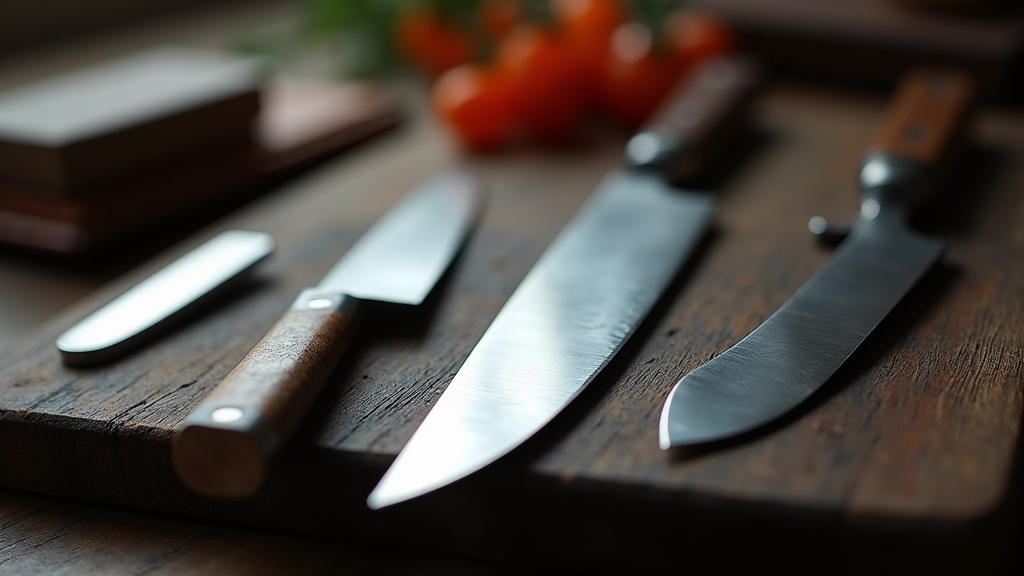
When it comes to knives, finding the right balance between sharpness and edge strength is key. You really want to consider the sharpening angle based on how you plan to use your knife. For example, specialized knives like the Yanagiba often require a more acute edge angle to achieve precision slicing for sashimi, which benefits from a sharper but more delicate blade.
For instance, if you’re looking for precision cutting, lower angles—around 15°—are great. They give you that super sharp edge, but here’s the catch: they can compromise the knife’s durability. Water stones or ultra-fine abrasives are often recommended for sharpening at these lower angles.
On the flip side, if durability is more your concern, you might want to lean towards higher angles, like 20°. This way, you enhance the toughness of the edge, but keep in mind that you might sacrifice a bit of that ultimate sharpness. This approach is common for versatile knives such as the Sujihiki, which balance sharpness with ease of maintenance.
Sharpness Versus Edge Strength
When selecting a sharpening angle, you must balance sharpness with edge durability to optimize performance. More acute angles produce sharper edges but reduce resistance to chipping, while obtuse angles strengthen the edge at the expense of fine cutting ability.
For instance, edges sharpened at 10° per side stay sharper about five times longer than those at 12.5°, yet they’re more prone to catastrophic failure under impact. Blade hardness impacts this trade-off: harder steels hold sharper edges but chip easier when thinned excessively, whereas softer steels offer toughness but dull faster.
Additionally, the choice of blade material such as high-carbon stainless steel or VG-10 significantly influences how well the edge retains sharpness over time. You should also consider grind types and bevels; a microbevel at a slightly larger angle boosts edge strength with minimal sharpness loss.
Ultimately, understanding these factors enables you to fine-tune your knife’s edge geometry for its intended tasks. Proper maintenance and regular honing with appropriate sharpening tools help preserve the selected edge angle and prolong blade life.
Optimal Angle Trade-offs
Balancing sharpness and durability requires careful selection of the sharpening angle based on your knife’s intended use.
If you prioritize precision for delicate slicing, angles between 10° and 15° deliver razor-sharp edges but sacrifice toughness.
Conversely, wider angles of 20° to 22.5° offer enhanced edge strength, suitable for general kitchen tasks and heavier chopping. Considering the stability of the blade during use can also influence the best angle choice.
Consider your blade steel and thickness: harder steels tolerate lower angles without chipping, while softer, thicker blades demand wider angles to maintain durability.
Employ precise sharpening tools like water stones or guided systems to consistently achieve your target angle, as deviation compromises performance. Using angle guides can greatly simplify maintaining a consistent sharpening angle and improve results.
Methods to Determine the Optimal Sharpening Angle
Although determining the most favorable sharpening angle can seem complex, several practical methods help you achieve precision and consistency.
You can fold a piece of paper twice to approximate a 22.5° angle, useful for hand sharpening near 20°. This simple folding method requires no additional tools and is accessible in any setting. Using angle guides can further ensure accuracy when sharpening manually.
Marking the blade bevel with a Sharpie and sharpening until the marker wears off ensures you’re maintaining the correct angle.
Angle guides or jigs provide fixed references for common angles like 15°, 20°, or 22°, enhancing repeatability.
Digital angle finders or protractors offer precise measurements, especially when setting sharpening tools.
Visual estimation combined with steady practice helps you develop a tactile sense of the blade’s edge relative to angle standards.
Employ these methods systematically to optimize your knife’s sharpness, edge retention, and durability.
Adjusting Angles Based on Knife Usage and Wear
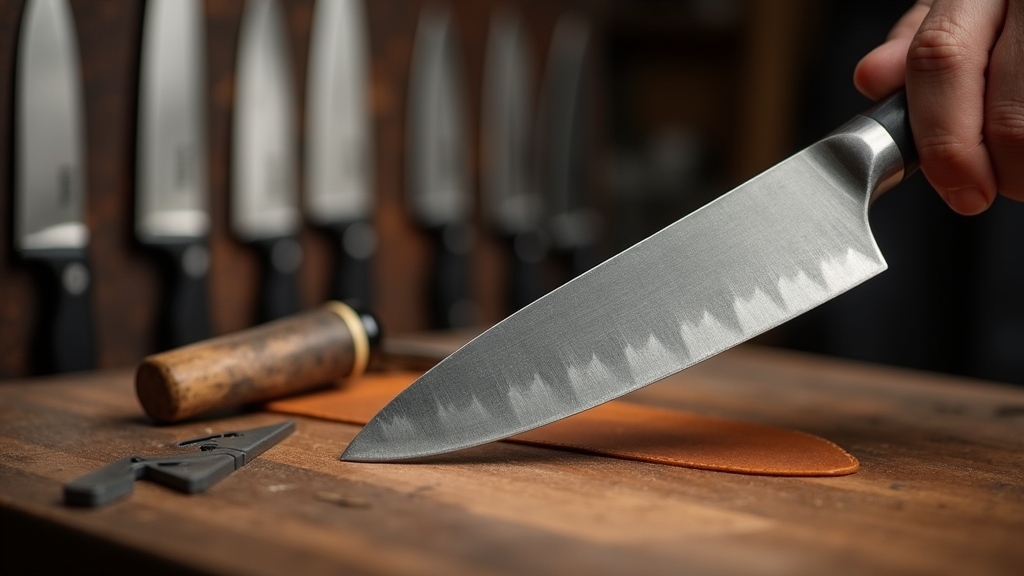
Since knife performance hinges on usage patterns and wear, you must adjust sharpening angles accordingly to optimize edge longevity and cutting efficiency. For delicate tasks, choose narrower angles (10°–15°) to enhance sharpness but expect faster dulling.
It is important to note that sharpening steels help maintain a razor-sharp edge over time without needing frequent resharpening. Polishing with the correct progression of grit levels can also refine the edge after sharpening for optimal performance.
Heavier usage or wear demands wider angles (≥22°) to improve edge durability. Regular sharpeners can maintain smaller angles, while infrequent sharpeners benefit from larger, more resilient edges. Monitor edge condition visually or via color tests to guide incremental angle increases, especially on softer steels prone to rapid wear.
| Usage Intensity | Recommended Angle | Wear Adjustment |
|---|---|---|
| Light (e.g., filleting) | 10°–15° | Maintain or slightly increase |
| Heavy (e.g., cleavers) | ≥22° | Increase to enhance durability |
| Frequent sharpening | 10°–15° | Maintain for precision |
Angle Selection for Different Knife Styles and Tasks
Adjusting sharpening angles based on knife usage and wear sets the stage for selecting precise angles tailored to specific knife styles and tasks.
For Western-style knives with softer steel, sharpen between 15° and 20° per side to balance edge durability and sharpness. Favor 20° for general prep and up to 22° for heavy chopping. These knives typically use double bevel designs for balanced cutting performance. Regular visual inspections help maintain their performance and safety.
Asian-style knives with harder, high-carbon steel benefit from more acute angles, typically 10° to 15°, enabling razor-sharp edges ideal for delicate slicing.
Single-bevel knives demand specialized, often sharper angles on the beveled side for precision, while double-bevel knives require symmetrical angles for versatility.
Task-specific angles range from 12° to 15° for fine slicing to 24° to 30° for cleavers handling heavy impact.
Tailor your angle selection to steel hardness and intended use for optimized performance and edge longevity.
Tools and Abrasives for Achieving Precise Angles
When you want to achieve precise sharpening angles, selecting the right tools and abrasives is vital. Adjustable angle guides and sharpeners let you set bevels between 15° and 25°, with compact designs enabling easy setup.
Achieve precise knife bevels effortlessly with adjustable angle guides and compact sharpeners.
Angle guides clip onto blades, ensuring real-time consistency, especially useful for beginners targeting typical 15° or 20° angles. Sharpening rails clamp onto blades, fixing height and guaranteeing consistent bevels, though with limited flexibility.
Choose abrasives strategically: diamond surfaces remove material quickly, while ceramic refines edges to polish. Multi-surface rods streamline progression from coarse to fine grits, maintaining angle integrity.
Power-assisted sharpeners combine speed with angle control, often including ceramic side refiners for finishing. Using these tools properly ensures precise, repeatable angles critical for ideal kitchen knife performance and longevity. For best results, it is important to maintain a consistent angle throughout the sharpening process.
Effects of Steel Hardness on Sharpening Angle
Although steel hardness plays a crucial role in determining the ideal sharpening angle, you must also consider the knife’s intended use and edge longevity.
Harder steels (60+ HRC) allow smaller angles (15–18°) because they retain edges longer but risk chipping. Softer steels (~56 HRC) require larger angles (20+) to maintain durability.
Carbide size and distribution further influence angle choice, as coarse carbides necessitate wider bevels. Balancing sharpness and toughness ensures maximum performance. Understanding the balance between sharpness and durability is key to selecting the optimal angle for different steels.
| Steel Hardness (HRC) | Recommended Angle (° per side) |
|---|---|
| 56 | 20+ |
| 58 | 18–20 |
| 60 | 15–20 |
| 64 | 15–18 |
| 68 | 15 or less |
Best Practices for Maintaining Knife Sharpness
Maintaining your knife’s sharpness demands consistent care through proper cleaning, storage, and regular edge maintenance. You should wash knives immediately after use with mild soap and warm water, avoiding abrasive sponges and dishwashers.
Dry them promptly to prevent rust. Store knives securely in blocks, magnetic strips, or sheaths to protect edges and ensure safety.
Regular honing realigns the blade edge, while sharpening with the correct angle (15°–20°) preserves edge integrity without over-wearing. It is important to hand wash knives only to avoid damage from harsh dishwasher cycles.
Remember to apply food-grade mineral oil sparingly on high-carbon blades to prevent corrosion. Follow these best practices:
- Clean knives immediately and dry thoroughly
- Store knives in dedicated holders, avoiding loose drawer storage
- Hone regularly; sharpen only when necessary at the correct angle
- Oil blades appropriately, especially high-carbon steel knives
Frequently Asked Questions
Can Sharpening Angles Affect Knife Safety During Use?
Yes, sharpening angles directly influence your knife’s safety during use.
When you sharpen at a lower angle (15–20 degrees), your blade cuts more efficiently with less force, reducing slip risk and enhancing control.
Sharpening at too high an angle creates a tougher but less precise edge, requiring more effort and increasing injury chances.
Maintaining the correct angle guarantees predictable blade behavior, preventing accidents and prolonging edge durability for safer handling.
How Does Humidity Impact Knife Sharpening Results?
Humidity holds heavy influence over honing.
You’ll notice high humidity helps maintain moisture on your whetstone, enhancing cooling and preventing heat buildup that could soften your blade’s temper.
However, excessive moisture might weaken stone integrity, causing cracks or warping that disrupt even sharpening.
Low humidity, conversely, can dry out the stone, increasing friction and risking edge damage.
Are Electric Sharpeners Adjustable to Specific Angles?
Yes, many electric sharpeners let you adjust sharpening angles precisely. You’ll find angle adjust knobs or digital inclinometers that let you set angles typically between 15° and 30°, matching your knife’s needs.
These systems maintain consistent edge geometry by holding the blade steady throughout sharpening. They’re designed for various blade styles, from fine slicing knives to robust chef’s knives, ensuring repeatable, accurate sharpening every time you use them.
Does the Handle Design Influence Sharpening Angle Choice?
Yes, handle design influences your sharpening angle choice because it affects grip comfort and blade control.
Ergonomic handles help you maintain a consistent angle, while bulky or slippery handles may cause angle variation.
Handle shape can limit wrist motion, impacting acute angle maintenance.
Also, handle size and material affect how you position the knife during sharpening, which indirectly dictates whether you adjust your angle for better control and edge consistency.
Can Sharpening Angle Affect Food Flavor or Texture?
You mightn’t realize that sharpening your knife at a 10-15° angle per side can considerably preserve food flavor and texture.
A finer edge causes less cell damage, minimizing juice loss and oxidation, which helps maintain natural flavors and crispness.
Conversely, steeper angles crush cells more, leading to mushy textures and bitterness.
Your Next Step: Practice Precision Sharpening for Effortless Cutting
Sharpening your kitchen knives at the right angle is like tuning a fine instrument. Precision guarantees peak performance.
By understanding manufacturer guidelines, blade type, and steel hardness, you can balance sharpness with durability. Adjust angles based on use and wear for ideal results.
Using proper tools and techniques guarantees consistent edges. Remember, maintaining the correct angle isn’t just a task; it’s the key to keeping your knives reliable and efficient every time you slice.

